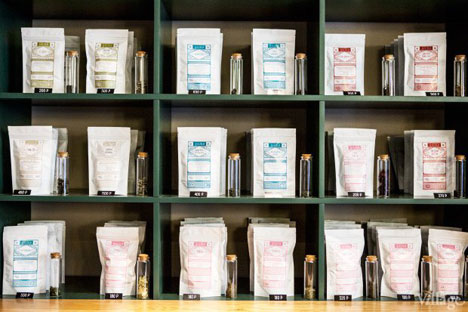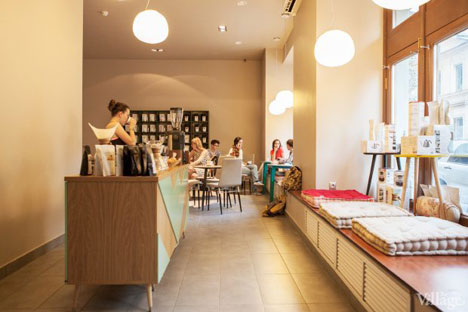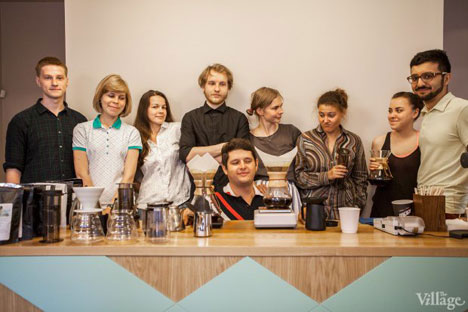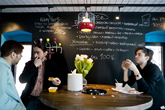Can a bar that only serves coffee survive in Russia?

Source: www.the-village.ru
The former general director of Kofeina, Anna Tsfasman, and the head barista of that chain, Olga Melik-Karakozova, resigned last year to develop their own product. They are launching a coffee house in a brew-bar format, which is unusual for the Russia market. The only item on the menu is coffee—albeit 15 different kinds brewed in five different ways, for example in a filter flask or an aeropress.
The first small coffee house, Double B, opened in the Ostankino television center in December 2012. In order to minimize the risks, Tsfasman and Melik-Karakozova began to trade in wholesale coffee prior to its opening. They purchased coffee beans from the Norwegian supplier Nordic Approach, and they manage quality and brew the coffee themselves. Anna is the manager while Olga specializes in brewing and sourcing the best coffee beans: She travels the world and attends coffee auctions.
Apart from an espresso and a cappuccino for 150–200 rubles ($4.60–6.20), signature drinks are sold here for 250 rubles ($7.70) a piece, together with the sauces to go with them. For example, for a strong latte, caramel with fresh sage is brewed, milk is whipped up and espresso is added, while powder made from blueberries is sprinkled over the top. For a lavender coffee aroma, they make sugar themselves from lavender.
This fledgling project has big ambitions. In fact, the coffee houses were given the name “Double B” because it would sound the same in any language, explains Tsfasman. The chain opened four coffee houses in the course of a year, and one of them is already operating as a franchise. Tsfasman and Melik-Karakozova had planned to open 30 franchises in a year; however, this pace turned out to be unrealistic due to a lack of suitable premises.
Tsfasman has invested $200,000 of her own money into Double B. An investor in the shape of SDS-Foods—the distributor for Ahmad Tea in Russia—came on board at the outset and invested around $800,000 in the project. “We are already making a profit, but we have not paid the money back yet. We are thinking we will start to pay it back from November,” says Tsfasman. “We are still reinvesting the money we make.”

Source: www.the-village.ru
The founders of the cooperative Cherniy, which opened a small outlet in the Polytechnic Museum’s Tsiolkovskiy bookshop in summer 2012, chose a much clearer strategy. Only black coffee is sold here, which is brewed using alternative methods: Milk and sugar are banned. In this case, it was proposed that the outlet would serve those who buy coffee to go. However, two barstools have been provided for those who love to drink their coffee sitting down. The price of a cup at Cherniy ranges from 104 to 150 rubles ($3.20–4.60).
The restaurant concept “just coffee and no food” is quite popular across the world. Brew-bars are widespread in the United States and Scandinavia and are starting to appear in London and in Australia. Among the most successful are Tim Wendelboe in Oslo, Intelligentsia in the U.S., and the Coffee Collective in Copenhagen. Tsfasman promises: “Given time, we will also be opening there too.” Tsfasman thinks that the example of brew-bars in the West shows that there is also potential for this format in Russia.
Tsfasman is convinced that, with shrewd organization, these brew-bars can become less costly than traditional cafes. “Food—like pastries, for example—is always wasteful, and, if you are not preparing it on site, then it is expensive to buy. Let’s say you sell 10 buns, and three are thrown away: The point is that the cabinet still needs to be clean and appetizing. We let people bring food in with them and [we] sometimes serve biscuits, dried fruits and nuts—that’s just the way it is,” she says.

Source: www.the-village.ru
Gleb Neveykin, the director of the barista department at the coffee chain Kofemania, is convinced that, in Russian culture, it is not acceptable to drink coffee on an empty stomach or pop into a café for a single cup of coffee. Even the customers at the Cherniy cooperative outlet have mentioned to the owners more than once that it would be a good idea to add rolls to the menu.
“Up until recently, the situation with coffee houses was complicated: Many of them placed their faith in coffee, but were forced to expand their menu to include food and are not among the most successful restaurants,” says Dmitry Levitsky, a restaurateur and general director of the consulting company Hurma Management Group.
Andrei Petrakov, the executive director of the consulting company Restcon, recalls that the first Russian coffee houses copied Western experience: They opened outlets where you could drink coffee and purchase the coffee beans, but outlets employing this concept have not survived. Putting your faith in coffee alone is quite a risky idea. However, times are changing and coffee is becoming a more independent drink; the share of its take-away sales is growing, the consultant noted.
Therefore, given a good choice of premises with sufficient trade, it can become very profitable to sell only coffee, Petrakov believes. Naturally, a coffee house selling just coffee is more like an idea for a small family business, which could very well become a popular, trendy place to be. It is doubtful, however, that brew-bars can become a big success story in Russia.
First published in Russian in Vedomosti.ru.
All rights reserved by Rossiyskaya Gazeta.
Subscribe
to our newsletter!
Get the week's best stories straight to your inbox

